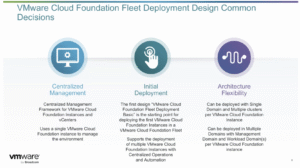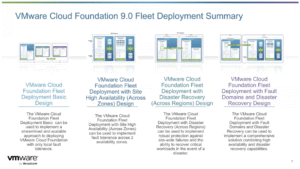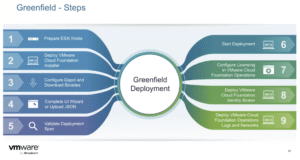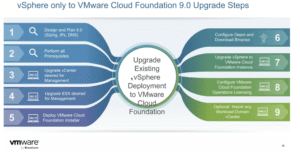
VMware Cloud Foundation 9.0 has arrived, bringing a fresh round of terminology updates, architectural diagrams, and the promise of making the hybrid cloud feel more manageable. Whether it fully delivers depends on how much patience you have for familiar ideas being reintroduced in new packaging. That said, the overall structure has been noticeably improved.
Federation Out, Fleet In
One of the more significant changes is the shift from Federation to Fleet. The concept isn’t entirely new, but the naming and architecture have been updated to reflect a more centralized and scalable model. Previously isolated VCF instances, each managed by its own SDDC Manager, can now be brought together under a single operational umbrella (with SDDC Manager still working in the background as an API provider). This is all managed through the newly introduced Operations component, which consolidates lifecycle tasks such as patching, certificate rotation, and password management into a unified interface. It’s a practical enhancement, especially for teams focused on reducing overhead in day-to-day operations.
Starting with the Basic Fleet
Deployments now begin with the Basic Fleet configuration, which includes core services such as vCenter, NSX, operations, automation, and storage, all centrally managed and organized into logically separated, tenant-style environments known as VPCs. It’s a streamlined foundation meant to scale. VMware encourages starting with this setup, then layering on high availability or disaster recovery features as needed. In practice, this approach supports a more iterative and realistic path to deployment.
More Storage Flexibility
A notable improvement is the expanded support for storage options. vSAN is no longer mandatory for the management domain – Fibre Channel and NFS are now supported natively. This added flexibility makes it easier to integrate VCF with existing infrastructure choices and removes some of the constraints that limited previous deployments.
Deployment Models That Scale
With that flexibility comes a clearer structure. VCF 9.0 now offers four deployment models: basic, high availability, disaster recovery, and a hybrid model that combines both. Teams can start with the basics and scale up into more complex designs as requirements evolve. Key considerations around IP portability and latency still apply, particularly when building multi-site configurations. Operations can extend across regions, though maintaining sub-100ms latency between vCenter and hosts remains essential for stability.
Modular Installer Replaces Cloud Builder
Also gone is the oversized Cloud Builder appliance. In its place is a modular installer that fetches only the components you need. Whether using an online or offline depot, this more efficient process simplifies installation and aligns better with current deployment practices.
Simplified Lifecycle and Operations Management
Lifecycle management has been significantly updated as well. Aria Lifecycle Manager has been retired, with Fleet Manager taking over as the central operations layer. It consolidates key administrative tasks and allows for scaling from simple installations to high availability or continuous availability, provided latency requirements are met. It’s a more coherent model, and one that should streamline long-term maintenance.
Upgrade Paths: Smoother, with Caveats
Upgrade processes have been improved, though there are still some prerequisites. Enhanced Linked Mode must be removed before migrating to VCF 9.0, and vSphere Update Manager has been replaced by vSphere Lifecycle Manager. The previous Identity Manager has also been replaced with VMware Identity Broker, which now handles authentication and integrates more easily with third-party identity providers. Overall, these changes reduce complexity and bring the platform closer to modern standards.
Sizing Still Requires Homework
Sizing guidance, however, is still evolving. VMware is working on a built-in calculator, but for now, infrastructure teams are left to estimate using documentation and planning tools. For example, automation appliances now require at least 24 vCPUs to run, which can catch teams off guard if not properly accounted for during hardware planning.
More Flexible Workload Domain Imports
Importing workload domains has become more straightforward. VCF 9.0 supports a wider range of storage and clustering configurations and allows the integration of external vCenters and NSX-enabled domains, as long as they’re running supported versions. Stretch clustering remains supported although the platform still enforces latency and object-count thresholds. These thresholds are relatively high, but still something to plan for if your environment is approaching scale limits.
Final Thoughts: A Platform with Room to Grow
Ultimately, VCF 9.0 represents a thoughtful evolution of the platform. It balances a more flexible approach to deployment with clear architectural guidance. There’s a stronger focus on scalability, centralization, and simplifying lifecycle management – all positive steps for enterprise IT teams. Like any large platform, it still carries complexity, and many features come with detailed requirements. But overall, the changes reflect a shift toward making VCF more adaptable and aligned with real-world needs.
If your organization is planning a move to VCF 9.0, begin with a solid design, verify your infrastructure assumptions, and work toward a deployment that can evolve with your needs. It doesn’t have to be perfect on Day One. What matters is building a foundation you can trust and grow from over time.
The VMware Cloud Foundation 9.0 Showcase: Powering the Modern Private Cloud was presented by VMware in association with Techstrong and Tech Field Day. The videos will be posted to the Tech Field Day YouTube channel and on the website. You can learn more about VMware Cloud Foundation 9.0 on the VMware website.





